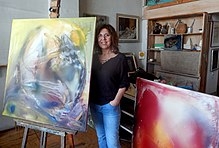Varteni Mosdichian
Monday, December 30, 2019
Varteni Mosdichian (Armenian: Վարդենի Մոստիչյան, born on June 24, 1953 in Istanbul) is a Boston-based Armenian American artist.
Varteni Mosdichian was born in 1953 in Istanbul to the Armenian family of Manouk Mosdichian and Zepur Elmayan. Her grantparents’ roots go back to Kayseri (Caesarea) in Central Anatolia and Bafra. She was educated at the Sourp Mesrobyan School, later at the Austrian Saint George Gymnasium. At age 16 she came to Boston, Massachusetts where she attended Lynn Classical High School and gained an early acceptance to California Institute of Arts. In 1979 she graduated from the College of Fine Arts, University of Central Florida, Orlando, FL.
During 1980’s she taught Art and Armenian language at AGBU School in Watertown, MA. Varteni's biography is listed in the 1999 Who's Who of American Women.
She was married to Canadian-Armenian conductor Nurhan Arman.
In most of Varteni's works Armenian themes play a major, but not overriding role. Some works, such as "Towards Embracing" are explicitly Armenian and use concrete symbolism. Other works are more subtle Armenian, and hold many different possibilities in store. The work "Peasants against the Wind" shows kneeling peasants who are bowed but not humiliated, steadfastly holding their own against the elements swirling around them.
Varteni's colors, visions, moments of remembrance and dream-like, almost unreal figures, almost invisible, merged in the texture of colors and patches of shadows and light embrace beauty and creative forces inherent in humankind, this by a woman whose personal history is full of deportation and exile, massacres and plunder suffered by her grandparents.
In most of Varteni's works Armenian themes play a major, but not overriding role. Some works, such as "Towards Embracing" are explicitly Armenian and use concrete symbolism. Other works are more subtle Armenian, and hold many different possibilities in store. The work "Peasants against the Wind" shows kneeling peasants who are bowed but not humiliated, steadfastly holding their own against the elements swirling around them.
Varteni's colors, visions, moments of remembrance and dream-like, almost unreal figures, almost invisible, merged in the texture of colors and patches of shadows and light embrace beauty and creative forces inherent in humankind, this by a woman whose personal history is full of deportation and exile, massacres and plunder suffered by her grandparents.
"Nevertheless to fuse and to feel the dichotomy between the physical and non physical I am going to choreograph an event in which every observer will be invited to participate by bringing their letters new or old, written material- to leave something behind and reminiscent of the stacks of envelopes in the drawer-- a labyrinth type of drawer where the individual can go in and leave behind its own trace by painting drawing or writing in private..(Hence we are only free in the privacy of our feelings and thoughts)… The history in drawers will connect those- us- who are destined to meet regardless of time and space… It can transform and travel".





